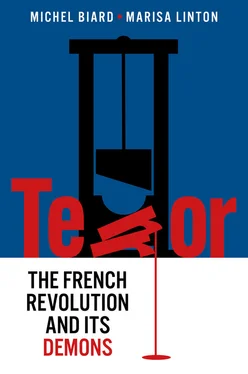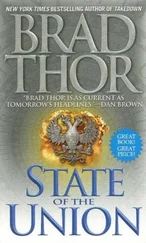28 28. Le Moniteur, 16 November 1792.
29 29. Ibid.
30 30. AP, vol. XCII, pp. 391–3.
31 31. Georges Lefebvre, The Great Fear of 1789: Rural Panic in Revolutionary France, Princeton, NJ, Princeton University Press, 1947 (original French edition, 1932); Timothy Tackett, When the King Took Flight, Cambridge, MA, Harvard University Press, 2003.
32 32. Le Moniteur, 21 April 1793.
33 33. AP, vol. LXXIV, pp. 315–16.
34 34. Ibid., vol. LII, p. 109.
35 35. Ibid., p. 139.
36 36. Discours à la Convention nationale le 3 décembre 1792 (OMR, vol. IX, p. 130).
37 37. Le Moniteur, 20 January 1793.
38 38. AP, vol. LII, p. 563.
39 39. Ibid., vol. LIII, p. 57.
40 40. Ibid., p. 349.
41 41. Ibid., vol. LXI, p. 48. On the 20th, Vergniaud’s fellow Girondin Gensonné claimed that ‘the majority of the inhabitants of Paris … does not abandon the exercise of its sovereignty’ to a handful of men who dominate ‘the sections by fear of proscriptions and by terror’: vol. LXIII, p. 18.
42 42. Marat, speaking after his acquittal by the Revolutionary Tribunal, claimed that policies of terror had brought him there, and could be used against other Montagnards: Le Moniteur, 3 May 1793.
43 43. Ibid., 10 July 1793.
44 44. An address by the Convention to the French, the day after the death of Le Peletier, was unambiguous on this point: ‘there is an attempt to sow terror in the Republic’ (AP, vol. LVII, p. 605). On the assassination of Le Peletier and Marat, see Michel Biard, La Liberté ou la mort. Mourir en député (1792–1795), Paris, Tallandier, 2015.
45 45. Convinced like all his fellow Montagnards that Corday was linked to the outlawed Girondins, some of whom had gathered in Calvados, where she came from, Couthon declared on 14 July that the Girondins ‘intended, through the assassination of the patriots, to produce a great terror’ (AP, vol. LXVIII, p. 723). On the impact of Marat’s assassination, see Guillaume Mazeau, Le bain de l’histoire. Charlotte Corday et l’attentat contre Marat 1793–2009, Seyssel, Champ Vallon, 2009; and Ian Germani, Jean-Paul Marat: Hero and Anti-Hero of the Revolution, New York, Edwin Mellen Press, 1992.
46 46. Jacques Guilhaumou, ‘“La terreur à l’ordre du jour”: un parcours en révolution(1793–1794)’, https://revolution-francaise.net/2007/01/06/94-la-terreur-a-lordre-du-jour-un-parcours-en-revolution-juillet-1793-mars-1794.
47 47. On fear of assassination, see Marisa Linton, ‘The Stuff of Nightmares: Plots, Assassinations, and Duplicity in the Mental World of Jacobin Leaders, 1793–1794’, in David Andress (ed.), Experiencing the French Revolution, Oxford, Studies on Voltaire and the Eighteenth Century, 2013, pp. 201–17.
48 48. The so-called ‘primary’ assemblies brought citizens together when they were asked to exercise their right to vote and elect.
49 49. On 4 July 1793, even before Marat’s assassination, Girondin Birotteau had already made this kind of statement – as inflamed as it was unfounded – during his visit to Lyon, a city then in revolt against the Convention: ‘There is no longer any Convention; there is only a handful of scoundrels in the temple of laws, who are fattened by your blood, who spend in four days all the income of the public treasury of a whole year … Citizens, let us not deceive ourselves, the deputies who remain at the Convention now present only a faction whose unique and cherished system is oppression … do not deliberate any more, but march on Paris; the universality of Paris is animated by the same principles as you’ (Michel Biard, 1793. Le siège de Lyon. Entre mythes et réalités, Clermont-Ferrand, Lemme édit, 2013, pp. 15–17).
50 50. AP, vol. LXX, p. 548.
51 51. Ibid., vol. LXXII, p. 102.
52 52. Ibid., p. 103.
53 53. See Jean-Clément Martin, Les échos de la Terreur. Vérités d’un mensonge d’Etat, 1794–2001, Paris, Belin, 2018, pp. 58–62.
54 54. See the work in particular of: Jean-Clément Martin, La terreur. Vérités et légendes, Paris, Perrin, 2017; Jean-Clément Martin, Les échos; and Annie Jourdan, Nouvelle histoire de la Révolution, Paris, Flammarion, 2018.
55 55. AP, vol. LXXIII, p. 420.
56 56. Ibid.
57 57. Michel Biard, Missionnaires de la République. Les représentants du peuple en mission (1793–1795), Paris, Editions du CTHS, 2002 (new edition: Paris, Vendémiaire, 2015).
58 58. AP, vol. LXXVI, p. 596.
59 59. Ibid., vol. LXXVII, p. 30.
60 60. Ibid., vol. LXXIX, p. 120.
61 61. See Guilhaumou, ‘La terreur’.
62 62. Ibid.
63 63. René Robinet, ‘Au Tribunal criminel du Nord: le jugement des “magistrats” municipaux nommés sous l’occupation autrichienne de 1793–1794’, Revue du Nord, 1989, no. 282–283, pp. 903–18.
64 64. Peter McPhee, Liberty or Death: The French Revolution, New Haven, CT, Yale University Press, 2016, p. 289.
65 65. Timothy Tackett, The Coming of the Terror in the French Revolution; and Marisa Linton, Choosing Terror. Virtue, Friendship and Authenticity in the French Revolution, Oxford, Oxford University Press, 2013.
Конец ознакомительного фрагмента.
Текст предоставлен ООО «ЛитРес».
Прочитайте эту книгу целиком, купив полную легальную версию на ЛитРес.
Безопасно оплатить книгу можно банковской картой Visa, MasterCard, Maestro, со счета мобильного телефона, с платежного терминала, в салоне МТС или Связной, через PayPal, WebMoney, Яндекс.Деньги, QIWI Кошелек, бонусными картами или другим удобным Вам способом.












